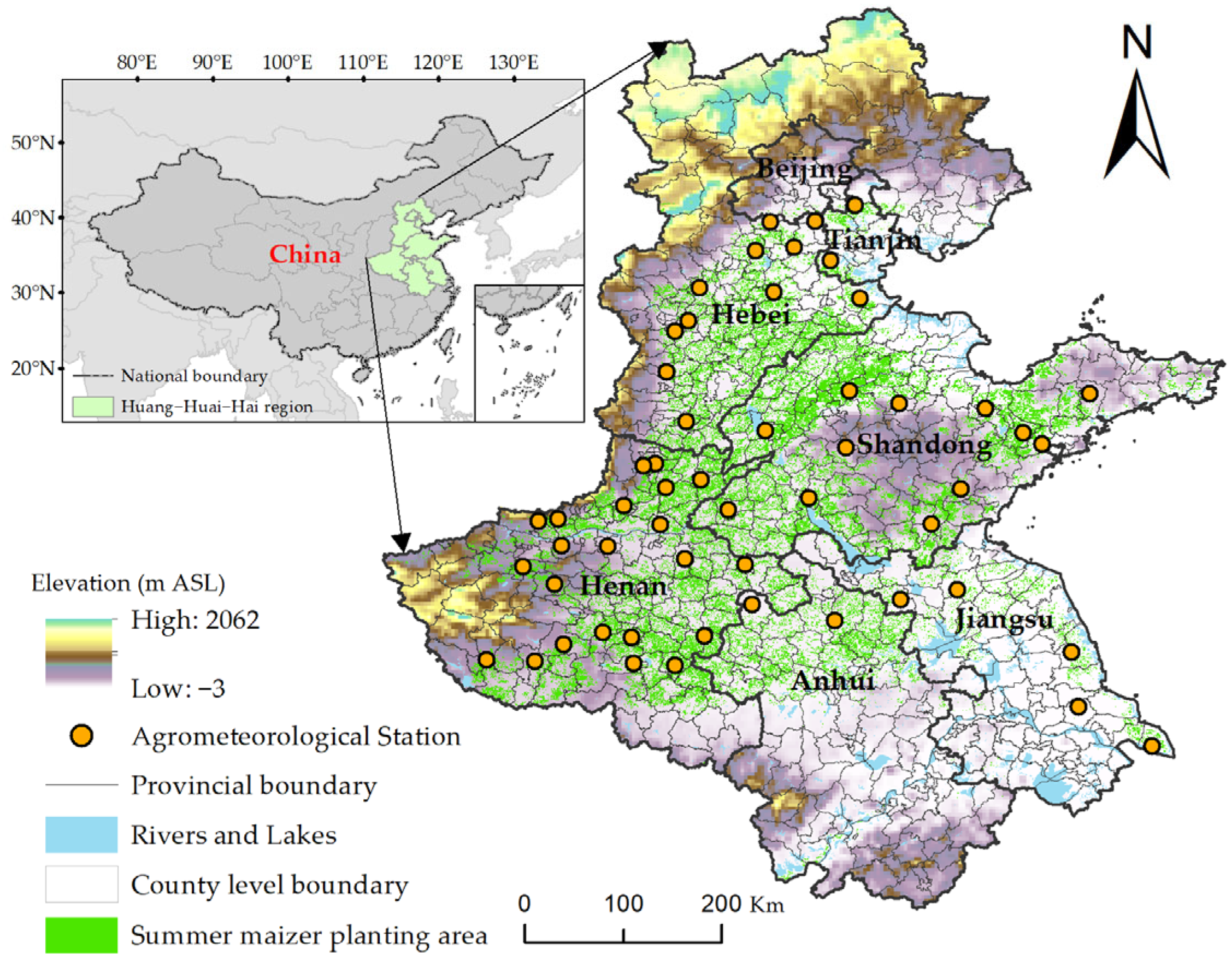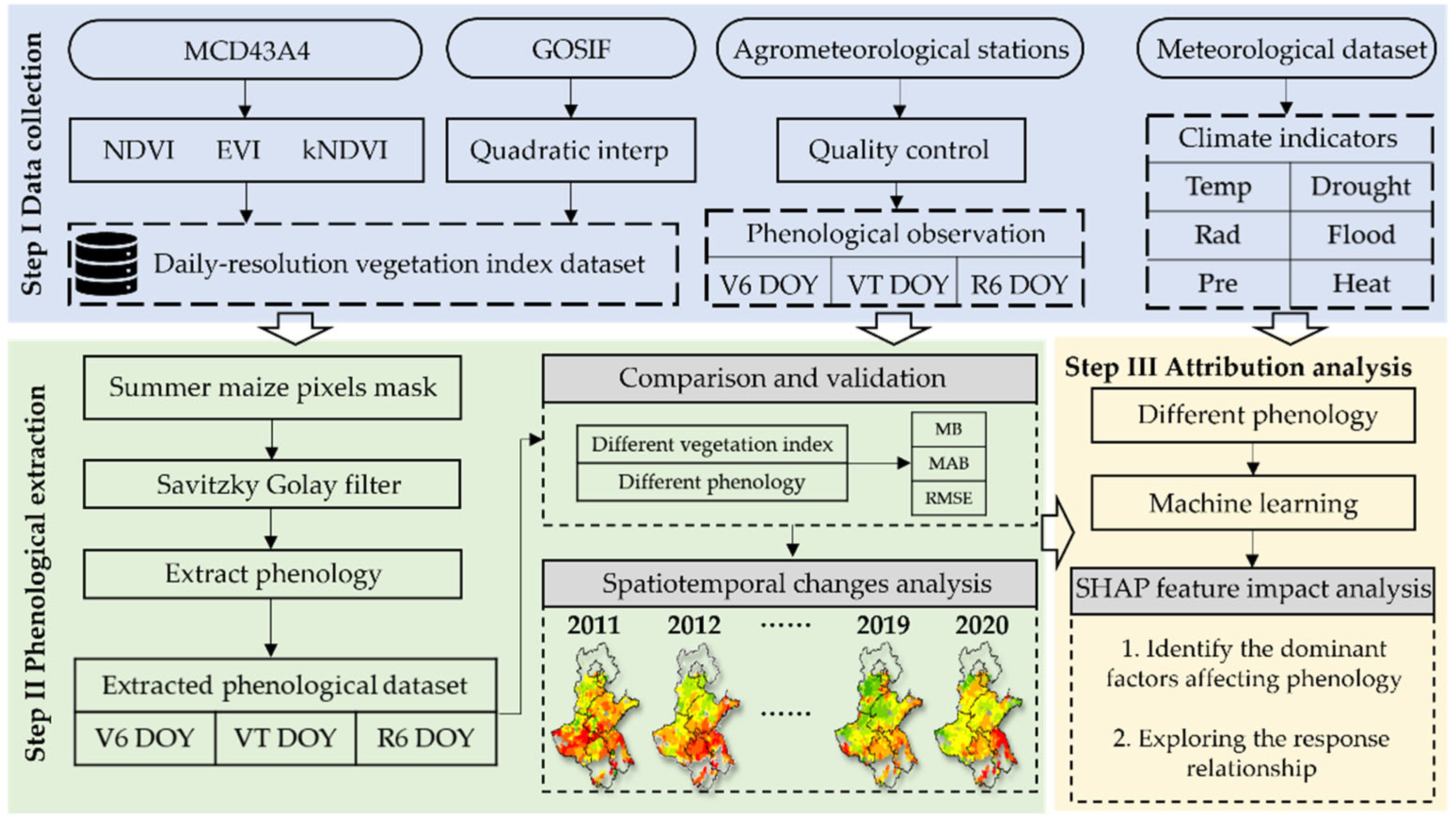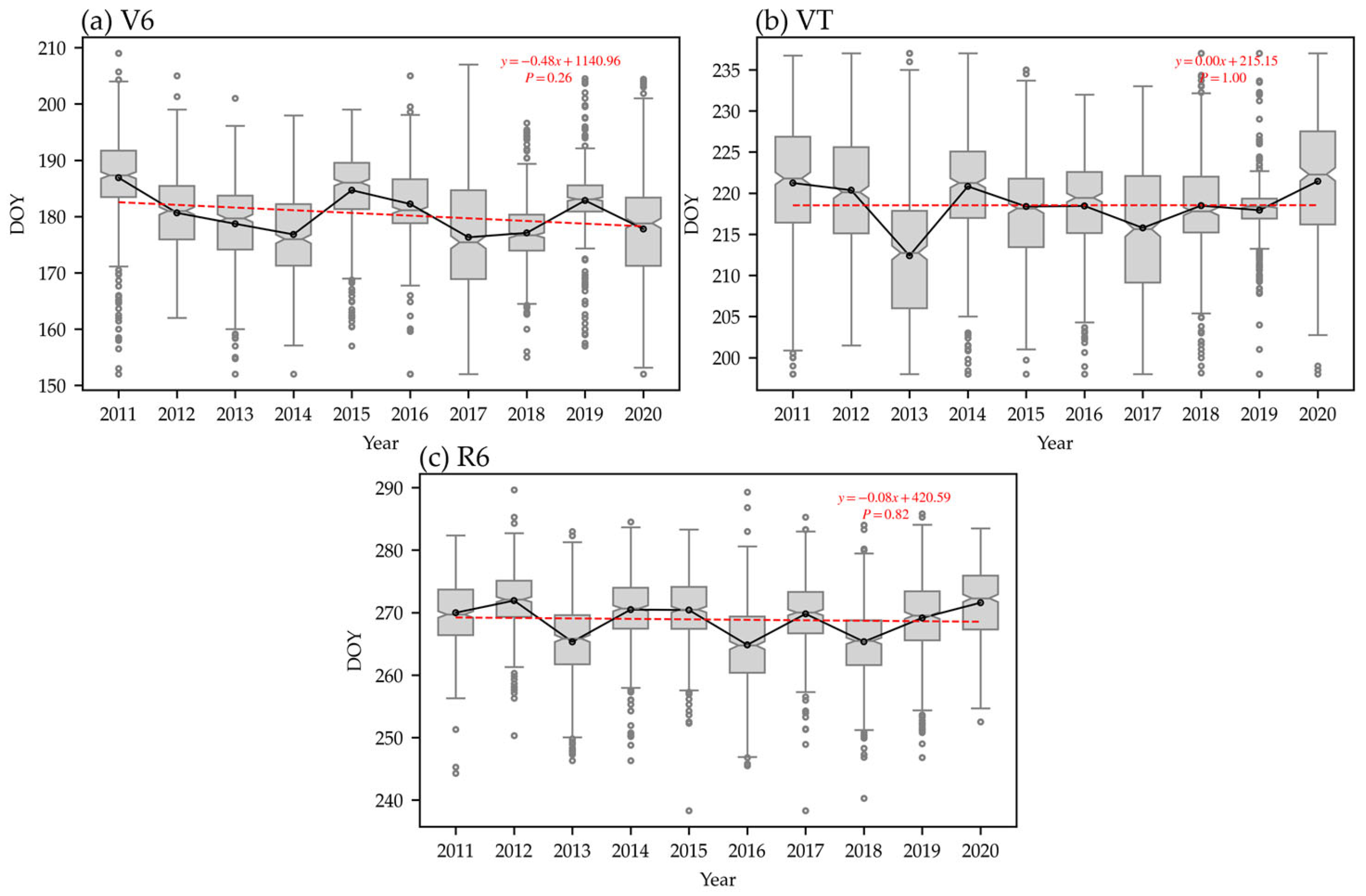Mapping the Main Phenological Spatiotemporal Changes of Summer Maize in the Huang-Huai-Hai Region Based on Multiple Remote Sensing Indices
Abstract
:1. Introduction
2. Materials and Methods
2.1. Study Region
2.2. Research Framework
2.3. Data Collection
2.4. Method
2.4.1. Calculation of the Vegetation Index
2.4.2. Filtering of Remote Sensing Data and Extraction of Summer Maize Phenology
2.4.3. Validation Metrics
2.4.4. Attribution of Phenological Influencing Factors
3. Results
3.1. Comparison and Validation of Phenological Accuracy Extracted from Vegetation Indices
3.2. Spatiotemporal Analysis of Phenological Variations in Summer Maize
3.3. Attribution Analysis of Drivers Affecting Phenological Phases of Summer Maize
4. Discussion
4.1. The Potential of the Vegetation Index for Extracting Crop Phenology
4.2. The Relationship Between Climate Drivers and Phenological Changes in Summer Maize
4.3. Applications, Limitations, and Future Directions
5. Conclusions
Author Contributions
Funding
Data Availability Statement
Conflicts of Interest
References
- Gao, F.; Zhang, X. Mapping Crop Phenology in Near Real-Time Using Satellite Remote Sensing: Challenges and Opportunities. J. Remote Sens. 2021, 2021, 8379391. [Google Scholar] [CrossRef]
- Liu, L.; Cao, R.; Chen, J.; Shen, M.; Wang, S.; Zhou, J.; He, B. Detecting crop phenology from vegetation index time-series data by improved shape model fitting in each phenological stage. Remote Sens. Environ. 2022, 277, 113060. [Google Scholar] [CrossRef]
- Sakamoto, T.; Wardlow, B.D.; Gitelson, A.A.; Verma, S.B.; Suyker, A.E.; Arkebauer, T.J. A Two-Step Filtering approach for detecting maize and soybean phenology with time-series MODIS data. Remote Sens. Environ. 2010, 114, 2146–2159. [Google Scholar] [CrossRef]
- Li, J.; Prentice, I.C. Global patterns of plant functional traits and their relationships to climate. Commun. Biol. 2024, 7, 1136. [Google Scholar] [CrossRef]
- Zhang, J.; Tong, X.; Zhang, J.; Meng, P.; Li, J.; Liu, P. Dynamics of phenology and its response to climatic variables in a warm-temperate mixed plantation. For. Ecol. Manag. 2021, 483, 118785. [Google Scholar] [CrossRef]
- Brown, M.E.; de Beurs, K.M.; Marshall, M. Global phenological response to climate change in crop areas using satellite remote sensing of vegetation, humidity and temperature over 26years. Remote Sens. Environ. 2012, 126, 174–183. [Google Scholar] [CrossRef]
- Bolton, D.K.; Friedl, M.A. Forecasting crop yield using remotely sensed vegetation indices and crop phenology metrics. Agric. For. Meteorol. 2013, 173, 74–84. [Google Scholar] [CrossRef]
- Zhong, L.; Hu, L.; Yu, L.; Gong, P.; Biging, G.S. Automated mapping of soybean and corn using phenology. ISPRS J. Photogramm. Remote Sens. 2016, 119, 151–164. [Google Scholar] [CrossRef]
- Yang, Y.; Tao, B.; Ruane, A.C.; Shen, C.; Matteson, D.S.; Cousin, R.; Ren, W. Widespread Advances in Corn and Soybean Phenology in Response to Future Climate Change Across the United States. J. Geophys. Res. Biogeosci. 2025, 130, e2024JG008266. [Google Scholar] [CrossRef]
- Li, M.; Tang, Y.; Li, C.; Wu, X.; Tao, X.; Liu, M. Climate warming causes changes in wheat phenological development that benefit yield in the Sichuan Basin of China. Eur. J. Agron. 2022, 139, 126574. [Google Scholar] [CrossRef]
- Caparros-Santiago, J.A.; Rodriguez-Galiano, V.; Dash, J. Land surface phenology as indicator of global terrestrial ecosystem dynamics: A systematic review. ISPRS J. Photogramm. Remote Sens. 2021, 171, 330–347. [Google Scholar] [CrossRef]
- Jeganathan, C.; Dash, J.; Atkinson, P.M. Remotely sensed trends in the phenology of northern high latitude terrestrial vegetation, controlling for land cover change and vegetation type. Remote Sens. Environ. 2014, 143, 154–170. [Google Scholar] [CrossRef]
- Xia, Z.; Li, Y.; Guo, S.; Bao, E.; Yuan, B.; Chen, R.; Tang, P.; Yang, C.; Du, P. The impact of photovoltaic plants on dryland vegetation phenology revealed by time-series remote sensing images. Agric. For. Meteorol. 2025, 367, 110505. [Google Scholar] [CrossRef]
- Shi, D.; Jiang, Y.; Li, W.; Wen, Y.; Wu, F.; Zhao, S. Spatial-temporal heterogeneity of spring phenology in boreal forests as estimated by satellite solar-induced chlorophyll fluorescence and vegetation index. Agric. For. Meteorol. 2024, 346, 109888. [Google Scholar] [CrossRef]
- Zhu, Q.; Wang, F.; Chen, S.; Peng, D.; Yi, Q.; He, L.; Liu, Z. Improved corn phenology monitoring using translation and weighting of characteristic points from time-series vegetation index. Comput. Electron. Agric. 2025, 234, 110297. [Google Scholar] [CrossRef]
- Jin, H.; Eklundh, L. A physically based vegetation index for improved monitoring of plant phenology. Remote Sens. Environ. 2014, 152, 512–525. [Google Scholar] [CrossRef]
- Pan, Z.; Huang, J.; Zhou, Q.; Wang, L.; Cheng, Y.; Zhang, H.; Blackburn, G.A.; Yan, J.; Liu, J. Mapping crop phenology using NDVI time-series derived from HJ-1 A/B data. Int. J. Appl. Earth Obs. Geoinf. 2015, 34, 188–197. [Google Scholar] [CrossRef]
- Peng, D.; Wu, C.; Li, C.; Zhang, X.; Liu, Z.; Ye, H.; Luo, S.; Liu, X.; Hu, Y.; Fang, B. Spring green-up phenology products derived from MODIS NDVI and EVI: Intercomparison, interpretation and validation using National Phenology Network and AmeriFlux observations. Ecol. Indic. 2017, 77, 323–336. [Google Scholar] [CrossRef]
- Yang, Y.; Ren, W.; Tao, B.; Ji, L.; Liang, L.; Ruane, A.C.; Fisher, J.B.; Liu, J.; Sama, M.; Li, Z.; et al. Characterizing spatiotemporal patterns of crop phenology across North America during 2000–2016 using satellite imagery and agricultural survey data. ISPRS J. Photogramm. Remote Sens. 2020, 170, 156–173. [Google Scholar] [CrossRef]
- Huete, A.; Didan, K.; Miura, T.; Rodriguez, E.P.; Gao, X.; Ferreira, L.G. Overview of the radiometric and biophysical performance of the MODIS vegetation indices. Remote Sens. Environ. 2002, 83, 195–213. [Google Scholar] [CrossRef]
- Camps-Valls, G.; Campos-Taberner, M.; Moreno-Martínez, Á.; Walther, S.; Duveiller, G.; Cescatti, A.; Mahecha, M.D.; Muñoz-Marí, J.; García-Haro, F.J.; Guanter, L.; et al. A unified vegetation index for quantifying the terrestrial biosphere. Sci. Adv. 2021, 7, eabc7447. [Google Scholar] [CrossRef] [PubMed]
- Qiu, R.; Li, X.; Han, G.; Xiao, J.; Ma, X.; Gong, W. Monitoring drought impacts on crop productivity of the U.S. Midwest with solar-induced fluorescence: GOSIF outperforms GOME-2 SIF and MODIS NDVI, EVI, and NIRv. Agric. For. Meteorol. 2022, 323, 109038. [Google Scholar] [CrossRef]
- Chen, R.; Liu, L.; Liu, X. Leaf chlorophyll contents dominates the seasonal dynamics of SIF/GPP ratio: Evidence from continuous measurements in a maize field. Agric. For. Meteorol. 2022, 323, 109070. [Google Scholar] [CrossRef]
- Zhang, J.; Xiao, J.; Tong, X.; Zhang, J.; Meng, P.; Li, J.; Liu, P.; Yu, P. NIRv and SIF better estimate phenology than NDVI and EVI: Effects of spring and autumn phenology on ecosystem production of planted forests. Agric. For. Meteorol. 2022, 315, 108819. [Google Scholar] [CrossRef]
- Pei, J.; Tan, S.; Zou, Y.; Liao, C.; He, Y.; Wang, J.; Huang, H.; Wang, T.; Tian, H.; Fang, H.; et al. The role of phenology in crop yield prediction: Comparison of ground-based phenology and remotely sensed phenology. Agric. For. Meteorol. 2025, 361, 110340. [Google Scholar] [CrossRef]
- Li, P.; Liu, Z.; Zhou, X.; Xie, B.; Li, Z.; Luo, Y.; Zhu, Q.; Peng, C. Combined control of multiple extreme climate stressors on autumn vegetation phenology on the Tibetan Plateau under past and future climate change. Agric. For. Meteorol. 2021, 308–309, 108571. [Google Scholar] [CrossRef]
- Zhu, D.; Wan, L.; Gao, W. Impacts of extreme weather events on daily vegetation phenological development in the Lesser Khingan Mountains of China. Ecol. Indic. 2025, 171, 113166. [Google Scholar] [CrossRef]
- Gao, X.; Tao, Z.; Dai, J. Significant influences of extreme climate on autumn phenology in Central Asia grassland. Ecol. Indic. 2023, 155, 111056. [Google Scholar] [CrossRef]
- Liu, Y.; Liu, X.; Fu, Z.; Zhang, D.; Liu, L. Soil temperature dominates forest spring phenology in China. Agric. For. Meteorol. 2024, 355, 110141. [Google Scholar] [CrossRef]
- Gu, Y.; Zhao, Y.; Guo, Z.; Meng, L.; Zhang, K.; Wang, J.; Lee, C.K.F.; Xie, J.; Wang, Y.; Yan, Z.; et al. The underappreciated importance of solar radiation in constraining spring phenology of temperate ecosystems in the Northern and Eastern United States. Remote Sens. Environ. 2023, 294, 113617. [Google Scholar] [CrossRef]
- Li, X.; Fu, Y.H.; Chen, S.; Xiao, J.; Yin, G.; Li, X.; Zhang, X.; Geng, X.; Wu, Z.; Zhou, X.; et al. Increasing importance of precipitation in spring phenology with decreasing latitudes in subtropical forest area in China. Agric. For. Meteorol. 2021, 304–305, 108427. [Google Scholar] [CrossRef]
- Sun, T.; Liu, B.; Hasegawa, T.; Liao, Z.; Tang, L.; Liu, L.; Cao, W.; Zhu, Y. Sink-source unbalance leads to abnormal partitioning of biomass and nitrogen in rice under extreme heat stress: An experimental and modeling study. Eur. J. Agron. 2023, 142, 126678. [Google Scholar] [CrossRef]
- Shi, P.; Tang, L.; Lin, C.; Liu, L.; Wang, H.; Cao, W.; Zhu, Y. Modeling the effects of post-anthesis heat stress on rice phenology. Field Crops Res. 2015, 177, 26–36. [Google Scholar] [CrossRef]
- Wang, Y.; Tian, D.; Xiao, J.; Li, X.; Niu, S. Increasing drought sensitivity of plant photosynthetic phenology and physiology. Ecol. Indic. 2024, 166, 112469. [Google Scholar] [CrossRef]
- Samuele, D.P.; Federica, G.; Filippo, S.; Enrico, B.-M. A simplified method for water depth mapping over crops during flood based on Copernicus and DTM open data. Agric. Water Manag. 2022, 269, 107642. [Google Scholar] [CrossRef]
- Erenstein, O.; Jaleta, M.; Sonder, K.; Mottaleb, K.; Prasanna, B.M. Global maize production, consumption and trade: Trends and R&D implications. Food Secur. 2022, 14, 1295–1319. [Google Scholar] [CrossRef]
- Zhao, J.; Yang, X.; Sun, S. Constraints on maize yield and yield stability in the main cropping regions in China. Eur. J. Agron. 2018, 99, 106–115. [Google Scholar] [CrossRef]
- Han, D.; Wang, P.; Ding, Y.; Tang, J.; Li, Y.; Wang, Q.; Ma, Y.; Wu, D. Improving the simulation accuracy of summer maize growth and yield by pixel-based parameterization based on assimilating upscaled MODIS LAI. Sci. Total Environ. 2024, 954, 176649. [Google Scholar] [CrossRef]
- Wang, P.; Wu, D.; Yang, J.; Ma, Y.; Feng, R.; Huo, Z. Summer maize growth under different precipitation years in the Huang-Huai-Hai Plain of China. Agric. For. Meteorol. 2020, 285–286, 107927. [Google Scholar] [CrossRef]
- Zhang, Y.; Wang, P.; Chen, Y.; Yang, J.; Wu, D.; Ma, Y.; Huo, Z.; Liu, S. Daily dynamic thresholds of different agricultural drought grades for summer maize based on the Vegetation Water Index. J. Hydrol. 2023, 625, 130070. [Google Scholar] [CrossRef]
- Wu, H.; An, S.; Meng, B.; Chen, X.; Li, F.; Ren, S. Retrieval of grassland aboveground biomass across three ecoregions in China during the past two decades using satellite remote sensing technology and machine learning algorithms. Int. J. Appl. Earth Obs. Geoinf. 2024, 130, 103925. [Google Scholar] [CrossRef]
- Li, X.; Xiao, J. A Global, 0.05-Degree Product of Solar-Induced Chlorophyll Fluorescence Derived from OCO-2, MODIS, and Reanalysis Data. Remote Sens. 2019, 11, 517. [Google Scholar] [CrossRef]
- Tie, R.; Shi, C.; Wan, G.; Hu, X.; Kang, L.; Ge, L. CLDASSD: Reconstructing Fine Textures of the Temperature Field Using Super-Resolution Technology. Adv. Atmos. Sci. 2022, 39, 117–130. [Google Scholar] [CrossRef]
- Liu, X.; Yu, S.; Yang, Z.; Dong, J.; Peng, J. The first global multi-timescale daily SPEI dataset from 1982 to 2021. Sci. Data 2024, 11, 223. [Google Scholar] [CrossRef]
- Luo, Y.; Zhang, Z.; Li, Z.; Chen, Y.; Zhang, L.; Cao, J.; Tao, F. Identifying the spatiotemporal changes of annual harvesting areas for three staple crops in China by integrating multi-data sources. Environ. Res. Lett. 2020, 15, 074003. [Google Scholar] [CrossRef]
- Wang, Q.; Moreno-Martínez, Á.; Muñoz-Marí, J.; Campos-Taberner, M.; Camps-Valls, G. Estimation of vegetation traits with kernel NDVI. ISPRS J. Photogramm. Remote Sens. 2023, 195, 408–417. [Google Scholar] [CrossRef]
- Zhou, J.; Jia, L.; Menenti, M.; Gorte, B. On the performance of remote sensing time series reconstruction methods—A spatial comparison. Remote Sens. Environ. 2016, 187, 367–384. [Google Scholar] [CrossRef]
- Hu, T.; Zhang, X.; Bohrer, G.; Liu, Y.; Zhou, Y.; Martin, J.; Li, Y.; Zhao, K. Crop yield prediction via explainable AI and interpretable machine learning: Dangers of black box models for evaluating climate change impacts on crop yield. Agric. For. Meteorol. 2023, 336, 109458. [Google Scholar] [CrossRef]
- Razavi, M.A.; Nejadhashemi, A.P.; Majidi, B.; Razavi, H.S.; Kpodo, J.; Eeswaran, R.; Ciampitti, I.; Prasad, P.V.V. Enhancing crop yield prediction in Senegal using advanced machine learning techniques and synthetic data. Artif. Intell. Agric. 2024, 14, 99–114. [Google Scholar] [CrossRef]
- Lundberg, S.M.; Lee, S.-I. A unified approach to interpreting model predictions. In Proceedings of the 31st International Conference on Neural Information Processing Systems, Long Beach, CA, USA, 4–9 December 2017; pp. 4768–4777. [Google Scholar]
- Chen, X.; Mo, X.; Zhang, Y.; Sun, Z.; Liu, Y.; Hu, S.; Liu, S. Drought detection and assessment with solar-induced chlorophyll fluorescence in summer maize growth period over North China Plain. Ecol. Indic. 2019, 104, 347–356. [Google Scholar] [CrossRef]
- Wu, Y.; Zhang, Z.; Wu, L.; Zhang, Y. Solar-induced chlorophyll fluorescence and its relationship with photosynthesis during waterlogging in a maize field. Agric. For. Meteorol. 2025, 363, 110404. [Google Scholar] [CrossRef]
- Lizaso, J.I.; Ruiz-Ramos, M.; Rodríguez, L.; Gabaldon-Leal, C.; Oliveira, J.A.; Lorite, I.J.; Sánchez, D.; García, E.; Rodríguez, A. Impact of high temperatures in maize: Phenology and yield components. Field Crops Res. 2018, 216, 129–140. [Google Scholar] [CrossRef]
- Slafer, G.A.; Kantolic, A.G.; Appendino, M.L.; Tranquilli, G.; Miralles, D.J.; Savin, R. Chapter 12—Genetic and environmental effects on crop development determining adaptation and yield. In Crop Physiology, 2nd ed.; Sadras, V.O., Calderini, D.F., Eds.; Academic Press: San Diego, CA, USA, 2015; pp. 285–319. [Google Scholar]
- Eyshi Rezaei, E.; Webber, H.; Gaiser, T.; Naab, J.; Ewert, F. Heat stress in cereals: Mechanisms and modelling. Eur. J. Agron. 2015, 64, 98–113. [Google Scholar] [CrossRef]
- Challinor, A.J.; Koehler, A.K.; Ramirez-Villegas, J.; Whitfield, S.; Das, B. Current warming will reduce yields unless maize breeding and seed systems adapt immediately. Nat. Clim. Change 2016, 6, 954–958. [Google Scholar] [CrossRef]
- Bheemanahalli, R.; Vennam, R.R.; Ramamoorthy, P.; Reddy, K.R. Effects of post-flowering heat and drought stresses on physiology, yield, and quality in maize (Zea mays L.). Plant Stress 2022, 6, 100106. [Google Scholar] [CrossRef]
- Gao, S.; Ming, B.; Li, L.; Hou, L.; Wang, K.; Zhou, S.; Xie, R.; Li, S. Grain water weight dynamics and their relationships with grain filling in maize. Eur. J. Agron. 2025, 164, 127481. [Google Scholar] [CrossRef]
- Gong, Z.; Ge, W.; Guo, J.; Liu, J. Satellite remote sensing of vegetation phenology: Progress, challenges, and opportunities. ISPRS J. Photogramm. Remote Sens. 2024, 217, 149–164. [Google Scholar] [CrossRef]
- He, L.; Asseng, S.; Zhao, G.; Wu, D.; Yang, X.; Zhuang, W.; Jin, N.; Yu, Q. Impacts of recent climate warming, cultivar changes, and crop management on winter wheat phenology across the Loess Plateau of China. Agric. For. Meteorol. 2015, 200, 135–143. [Google Scholar] [CrossRef]
- Zhang, J.; Liu, Y. Decoupling of impact factors reveals the response of cash crops phenology to climate change and adaptive management practice. Agric. For. Meteorol. 2022, 322, 109010. [Google Scholar] [CrossRef]
- Katari, S.; Bhowmik, T.K.; Nair, S.S.; Aravind, S.; Nayak, A.R.; Pankajakshan, P. Crop Phenology Stage Forecasting and Detection Using NDVI Time-Series and LSTM. In Proceedings of the IGARSS 2022–2022 IEEE International Geoscience and Remote Sensing Symposium, Kuala Lumpur, Malaysia, 17–22 July 2022; pp. 6264–6267. [Google Scholar]









| Dataset Name | Index | Time Frame | Temporal Resolution | Spatial Resolution | Purpose |
|---|---|---|---|---|---|
| MCD43A4 | NDVI | 2011–2020 | 1 day | 500 m | The extraction of summer maize phenology |
| EVI | |||||
| kNDVI | |||||
| GOSIF | SIF | 2011–2020 | 8 days | 0.05° | |
| CLDAS | Temp | 2011–2020 | 1 day | 0.05° | Attribution analysis of climate factors influencing phenological changes |
| Rad | |||||
| Pre | |||||
| SPEI-GD dataset | SPEI | 2011–2020 | 1 day | 0.25° | Attribution analysis of drought and flood stress factors affecting summer maize phenology |
| Phenophase | Vegetation Index | MB (Days) | MAB (Days) | RMSE (Days) |
|---|---|---|---|---|
| V6 | NDVI | 7.21 | 13.18 | 16.08 |
| EVI | 4.31 | 6.7 | 8.25 | |
| SIF | 3.29 | 6.24 | 7.86 | |
| kNDVI | 4.8 | 6.75 | 8.18 | |
| VT | NDVI | 7.79 | 13.81 | 16.2 |
| EVI | −0.06 | 8.33 | 10.4 | |
| SIF | −3.1 | 4.73 | 6.24 | |
| kNDVI | 0.76 | 4.08 | 5 | |
| R6 | NDVI | −7.34 | 17.68 | 22.85 |
| EVI | −5.92 | 9.9 | 12.75 | |
| SIF | 4.06 | 6.7 | 8.22 | |
| kNDVI | −5.63 | 9.04 | 11.91 | |
| Total | NDVI | 1.98 | 15.15 | 18.99 |
| EVI | −1.29 | 8.7 | 11.11 | |
| SIF | 1.13 | 5.84 | 7.43 | |
| kNDVI | −0.75 | 6.55 | 8.85 |
Disclaimer/Publisher’s Note: The statements, opinions and data contained in all publications are solely those of the individual author(s) and contributor(s) and not of MDPI and/or the editor(s). MDPI and/or the editor(s) disclaim responsibility for any injury to people or property resulting from any ideas, methods, instructions or products referred to in the content. |
© 2025 by the authors. Licensee MDPI, Basel, Switzerland. This article is an open access article distributed under the terms and conditions of the Creative Commons Attribution (CC BY) license (https://creativecommons.org/licenses/by/4.0/).
Share and Cite
Han, D.; Wang, P.; Li, Y.; Zhang, Y.; Guo, J. Mapping the Main Phenological Spatiotemporal Changes of Summer Maize in the Huang-Huai-Hai Region Based on Multiple Remote Sensing Indices. Agronomy 2025, 15, 1182. https://doi.org/10.3390/agronomy15051182
Han D, Wang P, Li Y, Zhang Y, Guo J. Mapping the Main Phenological Spatiotemporal Changes of Summer Maize in the Huang-Huai-Hai Region Based on Multiple Remote Sensing Indices. Agronomy. 2025; 15(5):1182. https://doi.org/10.3390/agronomy15051182
Chicago/Turabian StyleHan, Dianchen, Peijuan Wang, Yang Li, Yuanda Zhang, and Jianping Guo. 2025. "Mapping the Main Phenological Spatiotemporal Changes of Summer Maize in the Huang-Huai-Hai Region Based on Multiple Remote Sensing Indices" Agronomy 15, no. 5: 1182. https://doi.org/10.3390/agronomy15051182
APA StyleHan, D., Wang, P., Li, Y., Zhang, Y., & Guo, J. (2025). Mapping the Main Phenological Spatiotemporal Changes of Summer Maize in the Huang-Huai-Hai Region Based on Multiple Remote Sensing Indices. Agronomy, 15(5), 1182. https://doi.org/10.3390/agronomy15051182









